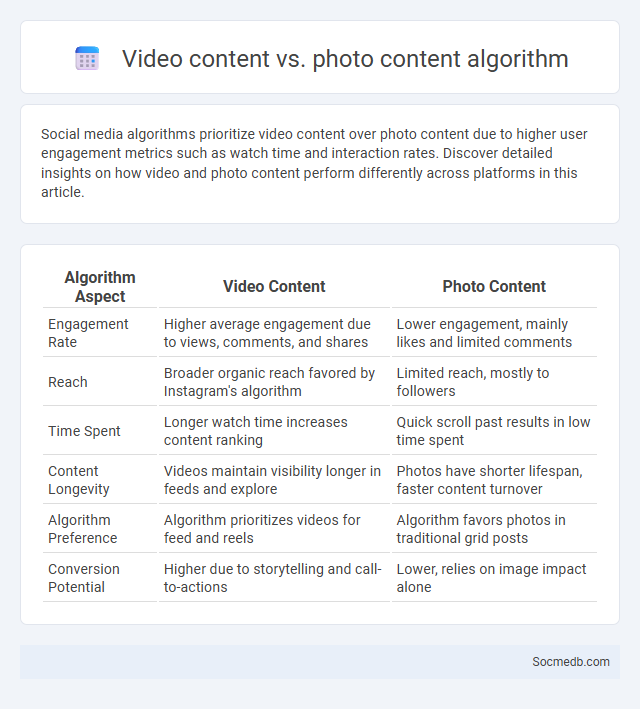
Photo illustration: Video content vs Photo content algorithm
Social media algorithms prioritize video content over photo content due to higher user engagement metrics such as watch time and interaction rates. Discover detailed insights on how video and photo content perform differently across platforms in this article.
Table of Comparison
| Algorithm Aspect | Video Content | Photo Content |
|---|---|---|
| Engagement Rate | Higher average engagement due to views, comments, and shares | Lower engagement, mainly likes and limited comments |
| Reach | Broader organic reach favored by Instagram's algorithm | Limited reach, mostly to followers |
| Time Spent | Longer watch time increases content ranking | Quick scroll past results in low time spent |
| Content Longevity | Videos maintain visibility longer in feeds and explore | Photos have shorter lifespan, faster content turnover |
| Algorithm Preference | Algorithm prioritizes videos for feed and reels | Algorithm favors photos in traditional grid posts |
| Conversion Potential | Higher due to storytelling and call-to-actions | Lower, relies on image impact alone |
Introduction to Video Content vs Photo Content
Video content on social media generates up to 1200% more shares than text and images combined, significantly boosting user engagement and brand visibility. In contrast, photo content offers faster loading times and immediate visual impact, making it ideal for quick storytelling and enhancing brand aesthetics. Understanding the distinct advantages of video and photo content helps marketers tailor strategies to maximize reach and audience interaction across platforms.
Understanding Social Media Algorithms
Social media algorithms use complex data patterns and user behavior analytics to curate and personalize content feeds, enhancing user engagement and session duration. These algorithms prioritize content based on factors such as relevance, user interactions, and recency, aiming to deliver the most appealing posts to each individual. Mastering the mechanics behind these algorithms enables marketers and creators to optimize content strategies for higher visibility and audience reach.
How Algorithms Rank Video Content
Social media algorithms rank video content primarily based on user engagement metrics such as likes, comments, shares, and watch time, signaling relevance and interest to the platform. These algorithms also analyze video metadata, including titles, descriptions, and hashtags, to understand content context and improve discoverability. By optimizing your video content with targeted keywords and encouraging interaction, you can enhance visibility and reach a broader audience.
How Algorithms Rank Photo Content
Algorithms rank photo content by analyzing various factors such as engagement metrics, relevance, and user behavior patterns. Your images that generate higher likes, comments, shares, and interactions are prioritized in feeds, boosting visibility. Advanced AI also assesses photo quality, subjects, and tags to optimize ranking within social media platforms.
Engagement Metrics: Video vs Photo
Engagement metrics reveal that videos on social media platforms generate 48% more interactions compared to photos, driving higher likes, shares, and comments. Video content increases user retention time by an average of 2x, enhancing algorithmic visibility and organic reach. Brands leveraging video posts report a 20% boost in follower growth rates relative to photo-centric strategies.
Algorithmic Preferences: Video or Photo?
Social media algorithms increasingly prioritize video content due to higher engagement rates, with platforms like Instagram and TikTok boosting video visibility to maximize user interaction. Photos still hold value for their quick consumption and shareability but often receive less organic reach compared to videos. To optimize your social media strategy, focus on creating engaging videos tailored to platform-specific preferences to enhance your content's performance.
Audience Reach and Visibility Differences
Social media platforms vary significantly in audience reach and visibility, with Facebook offering extensive reach through its large, diverse user base, while Instagram prioritizes visual content that appeals to younger demographics. Twitter provides real-time updates and broader public visibility for concise messages, whereas LinkedIn targets professional networks, enhancing business-related reach. Understanding these differences helps you tailor content strategies to maximize engagement and visibility within your desired audience segments.
Content Strategy: Choosing Video or Photo
Selecting between video and photo content in social media strategy depends on audience engagement metrics and platform algorithms; videos typically generate higher interaction rates and longer view times, boosting organic reach. Photo content excels in quick consumption and ease of sharing, making it ideal for brand awareness and visual storytelling on platforms like Instagram and Pinterest. Analyzing user demographics and content performance data helps optimize content mix, ensuring alignment with marketing goals and maximizing ROI.
Case Studies: Algorithmic Ranking in Action
Algorithmic ranking on social media platforms, such as Facebook and Instagram, personalizes your content feed by analyzing engagement patterns, user preferences, and historical interactions. Case studies reveal that these algorithms prioritize posts with higher relevance scores, boosting content visibility and user interaction rates. Understanding this process helps you optimize your content strategy to increase reach and engagement effectively.
Future Trends in Content and Algorithm Evolution
Social media platforms will increasingly leverage artificial intelligence and machine learning to deliver hyper-personalized content, enhancing user engagement and retention. Emerging trends include the integration of augmented reality (AR) and virtual reality (VR) for immersive experiences, as well as the rise of short-form video and ephemeral content dominating user interactions. Algorithm evolution will prioritize authenticity and user intent signals, reducing misinformation while promoting meaningful connections and diverse content exposure.
 socmedb.com
socmedb.com